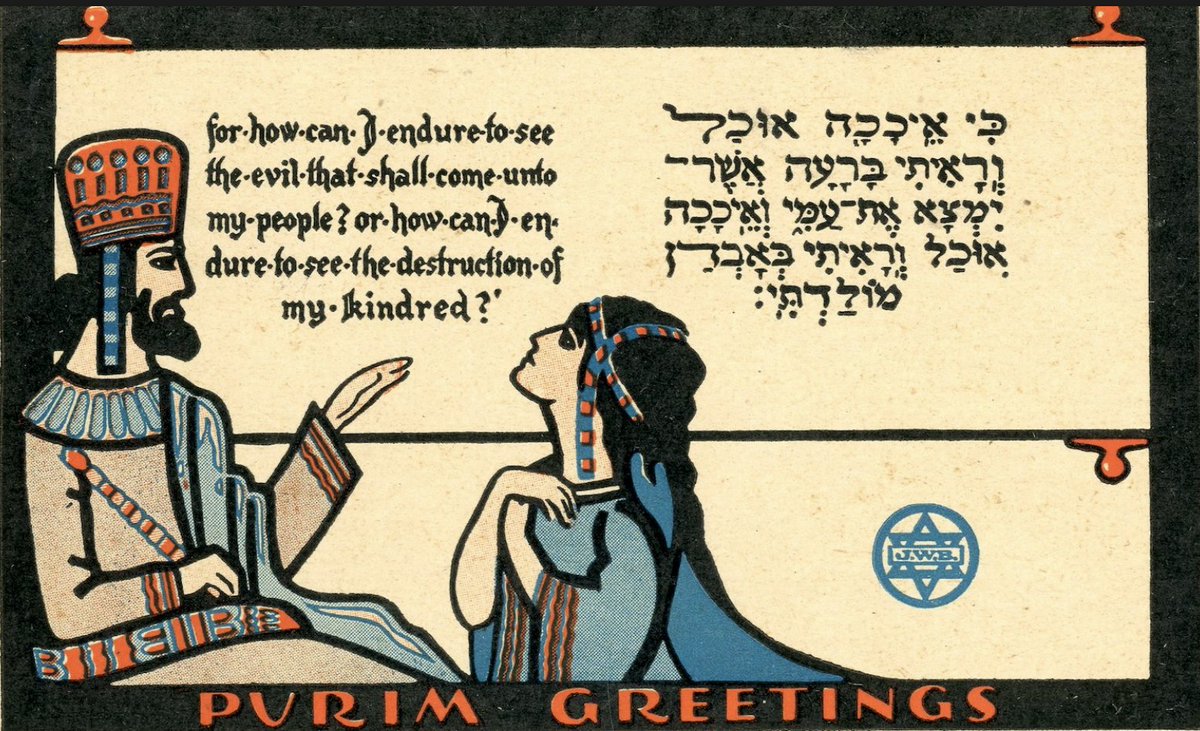
<A PURIM THREAD>
Nations rise and nations fall, but some stories about the persecution of the Jewish people are curiously and uncomfortably circular.
Below, I’ll share a few thoughts on some of the relevant circles.
Nations rise and nations fall, but some stories about the persecution of the Jewish people are curiously and uncomfortably circular.
Below, I’ll share a few thoughts on some of the relevant circles.

The book of Esther opens with a lavish description of Persia’s finery.
Multi-coloured fabrics,
an array of vessels from which to drink, each different from the other (כלים מכלים שונים),
and no laws or limits on the consumption of alcohol:
Multi-coloured fabrics,
an array of vessels from which to drink, each different from the other (כלים מכלים שונים),
and no laws or limits on the consumption of alcohol:
Persia rejoices in diversity and freedom.
Before too long, however, the Persians will become aware of a people-group who are different from the others—a people-group with different laws to those of others (דתיהם שנות מכל עם)—,
Before too long, however, the Persians will become aware of a people-group who are different from the others—a people-group with different laws to those of others (דתיהם שנות מכל עם)—,
at which point certain folk in Persia will start to wonder if diversity is such a great thing after all,
and whether a few laws and limits might not do some good.
Against that backdrop, the story of Purim unfolds.
and whether a few laws and limits might not do some good.
Against that backdrop, the story of Purim unfolds.
First up, we’re introduced to a man named Mordecai, whose credentials are noted in 2.5.
Mordecai is ‘the son of Jair, the son of Shimei, the son of Kish, a Benjaminite’.
At least two of these names should be familiar to us.
Mordecai is ‘the son of Jair, the son of Shimei, the son of Kish, a Benjaminite’.
At least two of these names should be familiar to us.
In 1 Samuel 9, we met a Benjaminite named Kish, who turned out to be the father of (the infamous) Saul (cp. 1 Sam. 9.1, 1 Chr. 8.29–33),
and, not long afterwards, we met a Benjaminite named Shimei, who turned out to be one of Saul’s sons (2 Sam. 16.5).
and, not long afterwards, we met a Benjaminite named Shimei, who turned out to be one of Saul’s sons (2 Sam. 16.5).
It doesn’t, therefore, seem too much of a stretch to identify 2.5’s ‘Shimei the son of Kish’ with Samuel’s ‘Shimei the son of Kish’,
which would make Mordecai and his cousin Esther descendants of Saul.
which would make Mordecai and his cousin Esther descendants of Saul.
——— THE SIGNIFICANCE OF ORIGINS ———
That Esther and Mordecai are framed as descendants of Saul isn’t an insignificant detail, since their rival (Haman) is one of Saul’s rivals—Agag the Amalekite,
the man whom Saul notoriously failed to make an end of.
That Esther and Mordecai are framed as descendants of Saul isn’t an insignificant detail, since their rival (Haman) is one of Saul’s rivals—Agag the Amalekite,
the man whom Saul notoriously failed to make an end of.
The book of Esther doesn’t, therefore, recount an isolated incident or a random ‘court tale’;
it describes a resurgence of an ancient rivalry—a replay of Saul and Agag’s battle in a different (Mesopotamian) world,
it describes a resurgence of an ancient rivalry—a replay of Saul and Agag’s battle in a different (Mesopotamian) world,
and, importantly, an opportunity for Esther to make amends for her ancestor’s failures.
Viewed against that backdrop, a number of unusual features of Esther’s story start to make sense.
Viewed against that backdrop, a number of unusual features of Esther’s story start to make sense.
Why does the book go to such lengths to tell us the Jews were permitted to plunder their enemies’ goods in Esther’s day (8.10–13), and then (repeatedly) tell us the Jews declined to do so?
The answer is because what takes place is a reversal/rectification of Saul’s failures (which is only to be expected in a book full of reversals).
Whereas Saul wasn’t permitted to plunder Agag’s goods and yet disobediently did so (and thrice proclaimed his innocence: 1 Sam. 15.13, 15, 20), the Jews *were* permitted to plunder the Haman-incited Persians’ goods and yet thrice *declined* to do so (Est. 9.10, 15, 16).
Significant for a similar reason is Esther’s attitude towards Mordecai.
Why does Esther go to such lengths to have Mordecai exalted alongside her in chs. 8–9 (and hence cause the story to drag)?
As before, the answer is because what takes place is a reversal of Saul’s failures.
Why does Esther go to such lengths to have Mordecai exalted alongside her in chs. 8–9 (and hence cause the story to drag)?
As before, the answer is because what takes place is a reversal of Saul’s failures.
Whereas Saul seeks to oust a man who’s been like a son to him (David), Esther seeks to promote a man who’s been like a father to her (Mordecai).
The same point is hinted at by 4.14’s turn of phrase, where Mordecai says to Esther,
The same point is hinted at by 4.14’s turn of phrase, where Mordecai says to Esther,
‘If you remain silent at the present time, you and your father’s house (את ובית אביך) will be lost!’.
Esther is an orphan.
Whose ‘house’ will be ‘lost’ if she fails to act? The answer, I suggest, is as follows: *Saul’s* house will be lost.
Esther is an orphan.
Whose ‘house’ will be ‘lost’ if she fails to act? The answer, I suggest, is as follows: *Saul’s* house will be lost.
Unless Esther can redeem her ancestor’s failures, Saul’s house will be remembered merely as a blot on the pages of Biblical history.
The book of Esther is thus framed as a recapitulation of Saul and Agag’s story.
Its intertextual connections, however, go far beyond what we’ve noted above.
Consider, for a start, some of the specific parallels between Esther and Saul’s early years.
Its intertextual connections, however, go far beyond what we’ve noted above.
Consider, for a start, some of the specific parallels between Esther and Saul’s early years.
🔹 Both are selected on the basis of their attractive physical appearance (1 Sam. 9.2), which is acknowledged by ‘all’ who see them (2.15 cp. 1 Sam. 10.24).
🔹 Both are selected by lot: Saul is the winner of a lottery (1 Sam. 10.21), while the lottery won by Esther comes in the form of a beauty contest.
🔹 Both are anointed with oil—Saul by Samuel, and Esther by the king’s beauticians.
🔹 Both are anointed with oil—Saul by Samuel, and Esther by the king’s beauticians.
🔹 Both are appointed by a ‘seer’—in Saul’s case, Samuel, and, in Esther’s, Memucan the ‘seer of the king’s face’ (רֹאֵי פְּנֵי הַמֶּלֶךְ).
🔹 And, at first, both act quite diffidently. Saul declines to ‘tell’ (להגיד) his uncle about his status as Israel’s king-to-be...
🔹 And, at first, both act quite diffidently. Saul declines to ‘tell’ (להגיד) his uncle about his status as Israel’s king-to-be...
... and keeps ‘silent’ (חרש) when his authority is questioned (10.27);
meanwhile, Esther declines to ‘tell’ (הגיד) people about her status as a Jew (2.10, 20) and is forced to break her vow of ‘silence’ (חרש) when Haman makes his move against the Jewish people (4.14).
meanwhile, Esther declines to ‘tell’ (הגיד) people about her status as a Jew (2.10, 20) and is forced to break her vow of ‘silence’ (חרש) when Haman makes his move against the Jewish people (4.14).
Esther and Saul’s careers thus take shape in similar ways.
The advent of 4.14, however, marks a critical juncture in our narrative.
And, happily, it also marks the point at which Esther and Saul’s paths begin to diverge,
The advent of 4.14, however, marks a critical juncture in our narrative.
And, happily, it also marks the point at which Esther and Saul’s paths begin to diverge,
...which explains some of the more unusual aspects of what follows in Esther’s story.
Consider the events of chs. 5–7. The king has just given Esther a blank cheque (up to the value of half his kingdom), and yet, rather than ask for the head of Haman on a platter, Esther invites the king and Haman to a series of banquets.
Why isn’t Esther more direct?
Why isn’t Esther more direct?
Why doesn’t she simply reveal her identity and ask the king to dispose of Haman for her?
Reasons concerned with Esther’s position in Persia can be adduced (on which the work of Rabbi David Fohrman is highly recommended),
Reasons concerned with Esther’s position in Persia can be adduced (on which the work of Rabbi David Fohrman is highly recommended),
but the question can also be answered intertextually on the basis of further parallels between Esther and Saul’s careers.
In 1 Samuel 20, as a result of David’s successes in life, Saul rapidly disintegrates.
When David fails to attend two consecutive feasts (held on consecutive days), Saul becomes enraged and vows to end David’s life, at which point his career goes into a tailspin.
When David fails to attend two consecutive feasts (held on consecutive days), Saul becomes enraged and vows to end David’s life, at which point his career goes into a tailspin.
Given what we’ve noted above, we might expect Esther’s story to parallel Saul’s when a threat to her position arises,
and it does.
Mercifully, however, Esther’s story *redeems* the relevant parallels.
and it does.
Mercifully, however, Esther’s story *redeems* the relevant parallels.
When Haman arises, Esther doesn’t lose control of her emotions;
instead, she reframes Haman’s threat to her as a threat to Artaxerxes, who *does* lose control of his emotions.
Esther thus directs the king’s anger towards her enemy, Haman,
instead, she reframes Haman’s threat to her as a threat to Artaxerxes, who *does* lose control of his emotions.
Esther thus directs the king’s anger towards her enemy, Haman,
whose death is, like David’s, pronounced on the second of two consecutive feasts (ch. 7).
And, significantly, as Esther’s life begins to diverge from Saul’s, Haman’s begins to line up with it.
And, significantly, as Esther’s life begins to diverge from Saul’s, Haman’s begins to line up with it.
Consumed with Saul-like envy, Haman turns against God’s chosen people and, consequently, his life begins to disintegrate in a Saul-like manner.
A man who has previously exalted him pronounces his downfall (cp. Haman and Artaxerxes w. Saul and Samuel),
A man who has previously exalted him pronounces his downfall (cp. Haman and Artaxerxes w. Saul and Samuel),
and, not long afterwards, Haman finds himself at the feet of a Jewish woman (cp. Saul and the witch of En-Dor),
overcome by grief and fear.
Haman’s life thus comes to a violent end, with his ten sons impaled on the same stake as him, which is remarkably Saul-like:
overcome by grief and fear.
Haman’s life thus comes to a violent end, with his ten sons impaled on the same stake as him, which is remarkably Saul-like:

As can be seen, the shape of Esther’s story makes careful use of particular aspects of 1 Samuel.
Where Saul goes wrong, Esther triumphs, and, consequently, it’s Haman rather than Esther who follows in the footsteps of the apostate Saul.
Where Saul goes wrong, Esther triumphs, and, consequently, it’s Haman rather than Esther who follows in the footsteps of the apostate Saul.

——— FURTHER CONNECTIONS ———
More, however, needs to be said about the historical backdrop to Esther’s story.
As we’ve seen, Esther isn’t merely about the lives of a few isolated individuals;
it’s rooted in the ancient rivalry between Saul and Agag.
More, however, needs to be said about the historical backdrop to Esther’s story.
As we’ve seen, Esther isn’t merely about the lives of a few isolated individuals;
it’s rooted in the ancient rivalry between Saul and Agag.
But then Saul and Agag aren’t themselves isolated individuals; they too are people with past histories, and their rivalry finds its root in an even more ancient rivalry, namely Jacob and Esau’s.
Saul is a descendant of Jacob, while Amalek is a descendant of Esau (cp. Gen. 36.12), and the Jacob-Esau rivalry is reflected in a number of ways in the book of Esther.
Consider, for instance, how Esau is supplanted by Jacob at two important meals.
Consider, for instance, how Esau is supplanted by Jacob at two important meals.
In Genesis 27, when Esau approaches Isaac to receive what’s been promised to him—or at least what he *thinks* has been promised to him—, he receives an unwelcome surprise.
And the experience of Haman the Esauite isn’t dissimilar.
And the experience of Haman the Esauite isn’t dissimilar.
Just as Esau enters Jacob’s presence to eat, drink, and be honoured, so Haman enters the king’s presence (for the same reasons).
Yet, just as Esau finds the tables have been turned on him courtesy of events at a previous meal (cp. Gen. 25’s soup), so too does Haman.
Yet, just as Esau finds the tables have been turned on him courtesy of events at a previous meal (cp. Gen. 25’s soup), so too does Haman.
Hence, just as what Esau expects to receive is granted to his rival (Jacob), so what Haman expects to receive is granted to *his* rival (Mordecai the Jacobite),
which causes Esau and Haman alike to ‘mourn’ (אבל).
which causes Esau and Haman alike to ‘mourn’ (אבל).
Haman’s contempt (בזה) for the line of promise thus brings about his downfall, just as Esau’s contempt (בזה) for God’s promise does (cp. Est. 3.6 w. Gen. 25.34)—a verbal connection which is also noted in Esther Rabbah 7.10.
With these things in mind, other events in Esther’s story can plausibly be seen as incidents which ‘fill up’ some of the Torah’s prophetic statements about Jacob and Esau’s future.
🔹 Rebekah’s seed are destined to inherit the ‘gate’/‘position’ of ‘those who hate them (שנאיו)’ (Gen. 24.60), which finds a notable echo in the triumph of Esther’s descendants over ‘those who hate them’ (אנאיהם) and in Mordecai’s inheritance of the house/position of Haman.
🔹 Jacob’s kinsmen—Esau included—are destined to bow before him (per Isaac’s benediction: Gen. 27.29), which finds an echo in Haman’s prostration before Queen Esther (7.6–8).
Meanwhile, it seems appropriate for Mordecai the Benjaminite to be the man who doesn’t bow before (and ultimately supplants) Agag the Esauite, since Benjamin is the only one of Jacob’s sons not to bow before Esau in Genesis 33. (Benjamin hasn’t been born by then.)
🔹 While Amalek’s name is not to be remembered, his evil deeds are (cp. Exod. 17.14 w. Deut. 25.17–19), which finds fulfilment in the text of 9.28,
...where Haman’s day of destruction is reinvented as a day of gladness, and the ‘remembrance’ of Purim thus displaces the ‘memory’ of Haman the Amalekite.
🔹 And, in Balaam’s prophecy, Amalek’s destruction (אבד) is associated with the rise of a particular ‘star’ and ‘sceptre’ from Jacob’s line,
which finds a curious echo in the rise of ‘Esther’ = ‘star’ and ‘Mordecai’ = ‘staff’, who together effect Haman the Amalekite’s destruction (אבד). 

——— FINAL THOUGHTS ———
The life of Esther is an instructive one, as it its relationship to Saul’s life.
Both Esther and Saul begin their careers in a spirit of modesty and humility,
but, before too long, Saul starts to get ideas above his station.
The life of Esther is an instructive one, as it its relationship to Saul’s life.
Both Esther and Saul begin their careers in a spirit of modesty and humility,
but, before too long, Saul starts to get ideas above his station.
He involves himself in priestly matters, which lie well outside his preserve (cp. 1 Sam. 14),
and even seeks to redefine the commandments of God in light of what God might, in retrospect, have preferred to say (cp. 1 Sam. 15).
and even seeks to redefine the commandments of God in light of what God might, in retrospect, have preferred to say (cp. 1 Sam. 15).
Esther, however, is cut from a different cloth, if not biologically, then spiritually.
Despite her elevated status in Persia’s kingdom, she acts with humility, and refuses to manipulate power for her own purposes;
Despite her elevated status in Persia’s kingdom, she acts with humility, and refuses to manipulate power for her own purposes;
instead, she seeks the good of her people and serves as a role model for the use of power and influence.
Hence, while Haman goes the way of Saul and Esau before him, Esther takes a higher path, and ends up in a higher place.
——— THE END ———
Hence, while Haman goes the way of Saul and Esau before him, Esther takes a higher path, and ends up in a higher place.
——— THE END ———
Note: For a brilliantly-put-together thread which explores similar connections, please see @devoninMENA’s latest contribution below:
https://twitter.com/devoninMENA/status/1364878723888078849
• • •
Missing some Tweet in this thread? You can try to
force a refresh










